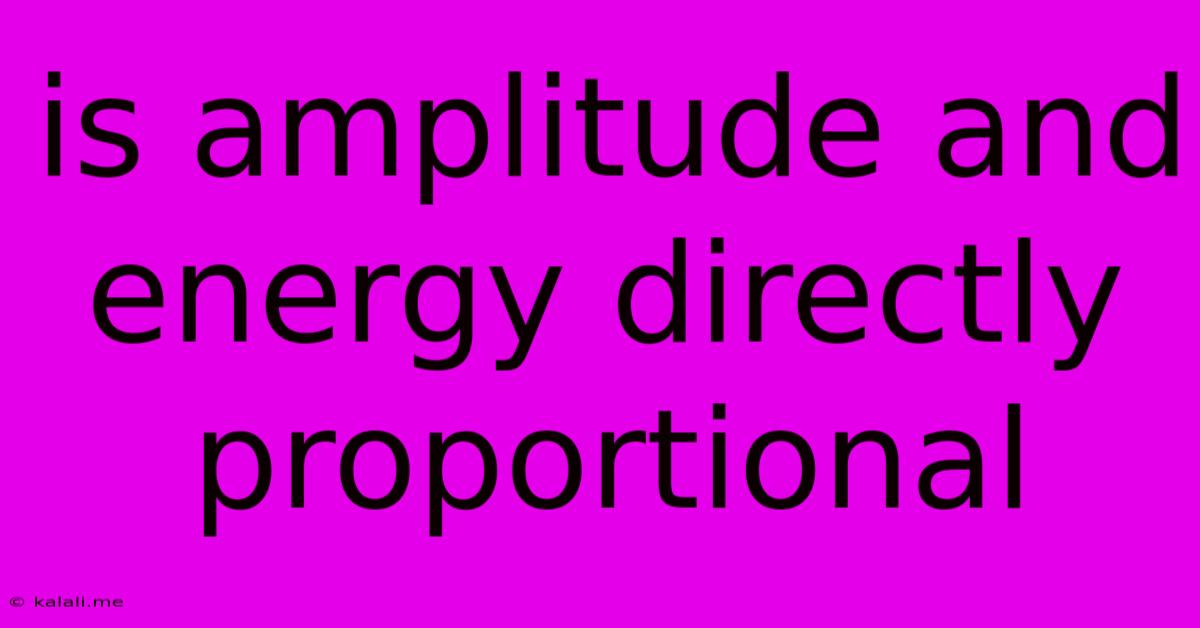Is Amplitude And Energy Directly Proportional
Kalali
Jun 07, 2025 · 3 min read

Table of Contents
Is Amplitude and Energy Directly Proportional? A Deep Dive into Wave Properties
Understanding the relationship between amplitude and energy in waves is fundamental to many fields, from physics and engineering to music and seismology. This article will explore the direct proportionality between a wave's amplitude and its energy, clarifying the nuances and offering practical examples. We'll also touch upon different types of waves and their energy considerations.
What is Amplitude?
Amplitude refers to the maximum displacement or distance moved by a point on a vibrating object or wave from its equilibrium position. Think of it as the "height" of a wave. In a sound wave, a larger amplitude translates to a louder sound. In a water wave, it means a higher crest and deeper trough.
What is Energy?
Energy, in the context of waves, represents the capacity to do work. Waves carry energy from one point to another. The energy of a wave is directly related to its ability to cause a change or perform work on an object it interacts with. For example, a high-energy wave can create larger ripples or even erode a coastline.
The Direct Proportionality: Amplitude Squared
The crucial point is this: the energy of a wave is directly proportional to the square of its amplitude. This means if you double the amplitude, you quadruple the energy. Triple the amplitude, and you increase the energy ninefold. This relationship holds true for many types of waves, including:
-
Sound Waves: A louder sound (higher amplitude) carries more energy. This is why a powerful speaker can be felt physically – it's transferring significantly more energy.
-
Light Waves: Brighter light (higher amplitude) possesses more energy. This explains why intense sunlight can cause sunburn – higher amplitude light waves carry more energy that can damage skin cells.
-
Seismic Waves: Larger seismic waves (higher amplitude) associated with powerful earthquakes carry substantially more energy, resulting in more devastating effects.
Mathematical Representation:
The relationship can be expressed mathematically as:
Energy ∝ Amplitude²
where the symbol '∝' denotes proportionality. To make it an equation, a constant of proportionality (dependent on the medium and type of wave) would be needed.
Exceptions and Nuances:
While the amplitude-squared relationship is a general rule, there are exceptions and nuances to consider:
-
Wave Damping: In real-world scenarios, energy is often lost due to factors like friction and absorption by the medium. This damping effect reduces the amplitude over time.
-
Wave Interference: When waves interact, their amplitudes can add or subtract, leading to complex energy patterns. Constructive interference increases the amplitude and energy, while destructive interference decreases them.
-
Wave Type: The precise relationship between amplitude and energy might vary slightly depending on the specific type of wave.
Conclusion:
In essence, while not a perfectly linear relationship, the energy of a wave is fundamentally tied to its amplitude. The energy is directly proportional to the square of the amplitude, meaning a small increase in amplitude can lead to a significant increase in energy. Understanding this relationship is crucial for comprehending the behavior and impact of various types of waves in diverse scientific and engineering applications.
Latest Posts
Latest Posts
-
Support For The Experimental Syntax Jsx Isnt Currently Enabled
Jun 07, 2025
-
Bolt Washer Lock Washer Nut Order
Jun 07, 2025
-
What Happens To Hal In Megaming
Jun 07, 2025
-
Gmail Signature Not Showing On Reply
Jun 07, 2025
-
What Can I Substitute For Gruyere Cheese
Jun 07, 2025
Related Post
Thank you for visiting our website which covers about Is Amplitude And Energy Directly Proportional . We hope the information provided has been useful to you. Feel free to contact us if you have any questions or need further assistance. See you next time and don't miss to bookmark.